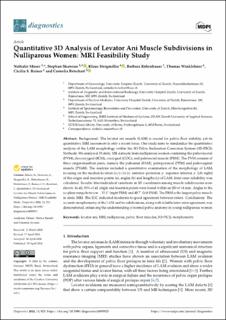Please use this identifier to cite or link to this item:
https://doi.org/10.21256/zhaw-31120Full metadata record
| DC Field | Value | Language |
|---|---|---|
| dc.contributor.author | Moser, Nathalie | - |
| dc.contributor.author | Skawran, Stephan | - |
| dc.contributor.author | Steigmiller, Klaus | - |
| dc.contributor.author | Röhrnbauer, Barbara | - |
| dc.contributor.author | Winklehner, Thomas | - |
| dc.contributor.author | Reiner, Cäcilia S. | - |
| dc.contributor.author | Betschart, Cornelia | - |
| dc.date.accessioned | 2024-07-28T12:58:32Z | - |
| dc.date.available | 2024-07-28T12:58:32Z | - |
| dc.date.issued | 2024-04-29 | - |
| dc.identifier.issn | 2075-4418 | de_CH |
| dc.identifier.uri | https://digitalcollection.zhaw.ch/handle/11475/31120 | - |
| dc.description.abstract | Background: The levator ani muscle (LAM) is crucial for pelvic floor stability, yet its quantitative MRI assessment is only a recent focus. Our study aims to standardize the quantitative analysis of the LAM morphology within the 3D Pelvic Inclination Correction System (3D-PICS). Methods: We analyzed 35 static MR datasets from nulliparous women examining the pubovisceral (PVM), iliococcygeal (ICM), coccygeal (COC), and puborectal muscle (PRM). The PVM consists of three origin-insertion pairs, namely the puboanal (PAM), puboperineal (PPM) and pubovaginal muscle (PVaM). The analysis included a quantitative examination of the morphology of LAM, focusing on the median location (x/y/z) (x: anterior–posterior, y: superior–inferior, z: left–right) of the origin and insertion points (a), angles (b) and lengths (c) of LAM. Inter-rater reliability was calculated. Results: Interindividual variations in 3D coordinates among muscle subdivisions were shown. In all, 93% of all origin and insertion points were found within an SD of <8 mm. Angles to the xz-plane range between −15.4° (right PRM) and 40.7° (left PAM). The PRM is the largest pelvic muscle in static MRI. The ICC indicated moderate-to-good agreement between raters. Conclusions: The accurate morphometry of the LAM and its subdivisions, along with reliable inter-rater agreement, was demonstrated, enhancing the understanding of normal pelvic anatomy in young nulliparous women. | de_CH |
| dc.language.iso | en | de_CH |
| dc.publisher | MDPI | de_CH |
| dc.relation.ispartof | Diagnostics | de_CH |
| dc.rights | https://creativecommons.org/licenses/by/4.0/ | de_CH |
| dc.subject | 3D-PICS | de_CH |
| dc.subject | MRI | de_CH |
| dc.subject | Levator ani | de_CH |
| dc.subject | Morphometry | de_CH |
| dc.subject | Nulliparous | de_CH |
| dc.subject | Pelvic floor muscles | de_CH |
| dc.subject.ddc | 616: Innere Medizin und Krankheiten | de_CH |
| dc.title | Quantitative 3D analysis of levator ani muscle subdivisions in nulliparous women : MRI feasibility study | de_CH |
| dc.type | Beitrag in wissenschaftlicher Zeitschrift | de_CH |
| dcterms.type | Text | de_CH |
| zhaw.departement | School of Engineering | de_CH |
| zhaw.organisationalunit | Institut für Mechanische Systeme (IMES) | de_CH |
| dc.identifier.doi | 10.3390/diagnostics14090923 | de_CH |
| dc.identifier.doi | 10.21256/zhaw-31120 | - |
| dc.identifier.pmid | 38732338 | de_CH |
| zhaw.funding.eu | No | de_CH |
| zhaw.issue | 9 | de_CH |
| zhaw.originated.zhaw | Yes | de_CH |
| zhaw.pages.start | 923 | de_CH |
| zhaw.publication.status | publishedVersion | de_CH |
| zhaw.volume | 14 | de_CH |
| zhaw.publication.review | Peer review (Publikation) | de_CH |
| zhaw.webfeed | BME Biomechanical Engineering - Soft Tissue Biomechanics | de_CH |
| zhaw.author.additional | No | de_CH |
| zhaw.display.portrait | Yes | de_CH |
| Appears in collections: | Publikationen School of Engineering | |
Files in This Item:
| File | Description | Size | Format | |
|---|---|---|---|---|
| 2024_Moser-etal_Quantitative-analysis-levator-ani-muscle-nulliparous_diagnostics.pdf | 4.17 MB | Adobe PDF |  View/Open |
Show simple item record
Moser, N., Skawran, S., Steigmiller, K., Röhrnbauer, B., Winklehner, T., Reiner, C. S., & Betschart, C. (2024). Quantitative 3D analysis of levator ani muscle subdivisions in nulliparous women : MRI feasibility study. Diagnostics, 14(9), 923. https://doi.org/10.3390/diagnostics14090923
Moser, N. et al. (2024) ‘Quantitative 3D analysis of levator ani muscle subdivisions in nulliparous women : MRI feasibility study’, Diagnostics, 14(9), p. 923. Available at: https://doi.org/10.3390/diagnostics14090923.
N. Moser et al., “Quantitative 3D analysis of levator ani muscle subdivisions in nulliparous women : MRI feasibility study,” Diagnostics, vol. 14, no. 9, p. 923, Apr. 2024, doi: 10.3390/diagnostics14090923.
MOSER, Nathalie, Stephan SKAWRAN, Klaus STEIGMILLER, Barbara RÖHRNBAUER, Thomas WINKLEHNER, Cäcilia S. REINER und Cornelia BETSCHART, 2024. Quantitative 3D analysis of levator ani muscle subdivisions in nulliparous women : MRI feasibility study. Diagnostics. 29 April 2024. Bd. 14, Nr. 9, S. 923. DOI 10.3390/diagnostics14090923
Moser, Nathalie, Stephan Skawran, Klaus Steigmiller, Barbara Röhrnbauer, Thomas Winklehner, Cäcilia S. Reiner, and Cornelia Betschart. 2024. “Quantitative 3D Analysis of Levator Ani Muscle Subdivisions in Nulliparous Women : MRI Feasibility Study.” Diagnostics 14 (9): 923. https://doi.org/10.3390/diagnostics14090923.
Moser, Nathalie, et al. “Quantitative 3D Analysis of Levator Ani Muscle Subdivisions in Nulliparous Women : MRI Feasibility Study.” Diagnostics, vol. 14, no. 9, Apr. 2024, p. 923, https://doi.org/10.3390/diagnostics14090923.
Items in DSpace are protected by copyright, with all rights reserved, unless otherwise indicated.